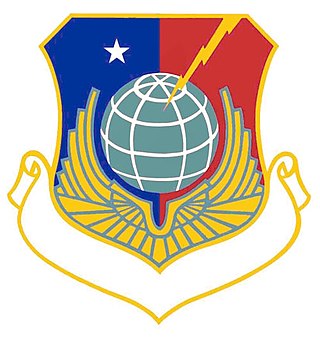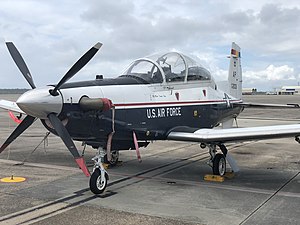
Mather Air Force Base was a United States Air Force Base, which was closed in 1993 pursuant to a post-Cold War BRAC decision. It was located 12 miles (19 km) east of Sacramento, on the south side of U.S. Route 50 in Sacramento County, California. Mather Field was one of 32 Air Service training camps established after the United States entry into World War I in April 1917.

The 453d Electronic Warfare Squadron is a United States Air Force unit. It is assigned to the 850th Spectrum Warfare Group and is stationed at Joint Base Lackland-San Antonio, Texas.

The 455th Air Expeditionary Wing was a provisional United States Air Force unit located at Bagram Airfield, Afghanistan, from 2002 to 2021. It was one of two expeditionary wings in Afghanistan. Most wing personnel were located at the Air Force Village known as Camp Cunningham.

The 741st Missile Squadron is a United States Air Force unit stationed at Minot Air Force Base, North Dakota. The squadron is equipped with the LGM-30G Minuteman III intercontinental ballistic missile, with a mission of nuclear deterrence.

The 740th Missile Squadron is a United States Air Force unit stationed at Minot Air Force Base, North Dakota. The squadron is equipped with the LGM-30G Minuteman III intercontinental ballistic missile, with a mission of nuclear deterrence.

The 323rd Air Expeditionary Wing is a provisional United States Air Force unit assigned to the United States Air Forces in Europe. As a provisional unit, it may be activated or inactivated at any time.

The 731st Airlift Squadron is a flying unit of the United States Air Force assigned to the Air Force Reserve Command and part of the 302d Airlift Wing at Peterson Air Force Base, Colorado. It operates Lockheed C-130H Hercules aircraft providing global airlift. The squadron also has the specialized mission of Modular Airborne Fire Fighting System.

The 449th Expeditionary Flying Training Squadron is a provisional United States Air Force unit. It was first activated as the 449th Bombardment Squadron in July 1942. After training in the United States, it deployed to the European Theater of Operations (ETO) in December 1942. It engaged in combat operations from 1943 to 1945, earning a Distinguished Unit Citation for demonstrating the effectiveness of medium bombers in the ETO. Following V-E Day, it participated in the disarmament of the Luftwaffe, until September 1945, when it returned to the United States for inactivation.

The 450th Expeditionary Flying Training Squadron is a provisional United States Air Force unit. The squadron was first activated as the 450th Bombardment Squadron in July 1942. After training in the United States, it deployed to the European Theater of Operations (ETO) in December 1942. It engaged in combat operations from 1943 to 1945, earning a Distinguished Unit Citation for demonstrating the effectiveness of medium bombers in the ETO. Following V-E Day, it participated in the disarmament of the Luftwaffe until September 1945, when it returned to the United States for inactivation.

The 742d Missile Squadron is a United States Air Force unit stationed at Minot Air Force Base, North Dakota. The squadron is equipped with the LGM-30G Minuteman III intercontinental ballistic missile, with a mission of nuclear deterrence.

The 452nd Flight Test Squadron is an active United States Air Force squadron. It is assigned to the 412th Operations Group of Air Force Materiel Command, stationed at Edwards Air Force Base, California, where it performs flight testing on unmanned aerial vehicles. The squadron was first activated as the 452nd Bombardment Squadron in July 1942. After training in the United States, it deployed to the European Theater of Operations (ETO) in December 1942. It engaged in combat operations from 1943 to 1945, earning a Distinguished Unit Citation for demonstrating the effectiveness of medium bombers in the ETO. Following V-E Day, it participated in the disarmament of the Luftwaffe until September 1945, when it returned to the United States for inactivation.

The 91st Operations Group is the operational component of the 91st Missile Wing, assigned to the Air Force Global Strike Command Twentieth Air Force. It is stationed at Minot Air Force Base, North Dakota.

The 323d Strategic Reconnaissance Squadron is an inactive United States Air Force unit. Its last was assigned to the 91st Strategic Reconnaissance Wing, stationed at Lockbourne Air Force Base, Ohio. It was inactivated on 8 November 1957.

The 451st Flying Training Squadron is an active United States Air Force unit. It is assigned to the 479th Flying Training Group, stationed at Naval Air Station Pensacola, Florida. The squadron was first activated as the 451st Bombardment Squadron in July 1942. After training in the United States, it deployed to the European Theater of Operations (ETO) in December 1942. It engaged in combat operations from 1943 to 1945, earning a Distinguished Unit Citation for demonstrating the effectiveness of medium bombers in the ETO. Following V-E Day, it participated in the disarmament of the Luftwaffe until September 1945, when it returned to the United States for inactivation.

The 456th Bombardment Squadron is one of the two predecessors of the 556th Tactical Air Support Squadron, an inactive United States Air Force unit. Formed in 1985 by the consolidation of the 456th with another inactive bombardment squadron. It has never been active under its most recent designation.

The 454th Flying Training Squadron is an inactive United States Air Force unit. It was last assigned to the 323d Flying Training Wing at Mather Air Force Base, California, where it was inactivated on 31 May 1993.

The 733rd Military Airlift Squadron is an inactive United States Air Force unit. It was activated as the 333rd Bombardment Squadron during World War II. After training in the United States, it deployed to the European Theater of Operations, where it participated in the strategic bombing campaign against Germany, earning a Distinguished Unit Citation. It was inactivated in England following V-E Day.

The 410th Bombardment Squadron is an inactive United States Air Force unit, formerly assigned to the 94th Bombardment Group. It was inactivated at Dobbins Air Force Base, Georgia on 20 March 1951 after being called to active duty for the Korean War, with its personnel used as "fillers" to bring other units up to strength.

The 743d Bombardment Squadron was first activated in June 1943. After training in the United States with the Consolidated B-24 Liberator bombers, the 743d deployed to the Mediterranean Theater of Operations, participating in the strategic bombing campaign against Germany. It earned two Distinguished Unit Citations for its combat operations. Following V-E Day, it remained in Italy without its flight echelon until inactivating in September 1945

The 323d Expeditionary Operations Group is a provisional United States Air Force unit assigned to the United States Air Forces in Europe. As a provisional unit, it may be activated or inactivated at any time.
























